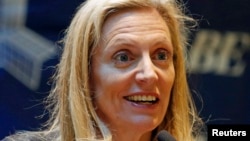Experts at the U.S. central bank said Wednesday that the U.S. economy started growing again in April and May after shrinking slightly in the first few months of the year.
The assessment came from a survey of businesses across the nation designed to give Federal Reserve officials an up-to-date view of the economy as they consider changing the key interest rate two weeks from now. The Fed has slashed rates nearly to zero during the financial crisis in a bid to boost economic growth and cut unemployment.
In its report Wednesday, the Fed said manufacturing had improved in most areas, except for the energy industry, where falling oil prices have hurt investment. The survey, called the "Beige Book," collects anecdotal reports of business activity across the nation. In this case, the reports showed rising auto sales, increased demand for loans and more consumer spending.
A separate report showed that the services sector of the economy displayed continued growth, but at a slower pace than previously thought. A different study showed the trade picture improving, with fewer imports and more exports. U.S. exports have been hampered by the strong dollar, which raises the cost of U.S.-made goods to foreign customers. Also, a company that processes paychecks said private-sector employment rose 201,000 in May.
On Thursday and Friday, government experts will report the number of people applying for unemployment aid, the net gain in jobs across the economy and the unemployment rate.
The jobless rate will probably stay steady at 5.4 percent, and the economy is likely to show a gain of 220,000 jobs, according to a survey of economists by the Bloomberg financial news service.
The recent blend of gloomy and positive economic data is complicating the task of the Federal Reserve as it tries to steer the economy toward full employment and stable prices.
Earlier this week, Lael Brainard, a member of the Fed's Board of Governors, said the U.S. economy's weak growth in the first few months might continue longer than many experts have expected. The economy contracted at an annual rate of 0.7 percent in the first few months of this year, which was blamed on temporary factors, including unusually foul winter weather and labor problems at key ports.
Brainard said falling oil prices have saved consumers a lot of money, but they are saving rather than spending it. These cautious consumers are not giving the economy the kind of boost many experts expected. She said slower growth in China's economy and worries about Greece's debt problems were among the other factors that could hamper U.S. trade and growth.






